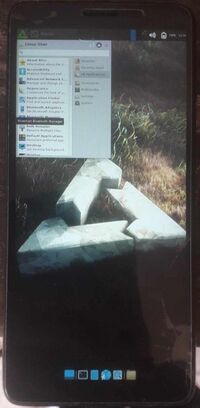Samsung Galaxy M01 Core
Appearance
| This device has been tested with postmarketOS, but its device package has not yet been added to the postmarketOS repositories. This means that it cannot be selected in pmbootstrap. Status: Device Successfully Boots with GUI |
 M01 Core Running PMOS with Downstream Kernel | |
| Manufacturer | Samsung |
|---|---|
| Name | Samsung Galaxy M01 Core |
| Codename | samsung-m013f |
| Model | SM-M013F/DS |
| Released | 2018 |
| Type | handset |
| Hardware | |
| Chipset | MediaTek MT6739 |
| CPU | Quad-core 1.5 GHz Cortex-A53 |
| GPU | PowerVR GE8100 |
| Display | 720 x 1480 PLS LCD @ 60Hz, 18.5:9, 5.3" |
| Storage | 16/32 GB |
| Memory | 1/2 GB |
| Architecture | armv7 |
| Software | |
Original software The software and version the device was shipped with. |
Android Android 10 GO Edition |
Extended version The most recent supported version from the manufacturer. |
Android |
| FOSS bootloader | no |
| postmarketOS | |
Pre-built images Whether pre-built images are available from the postmarketOS Installation page. |
no |
Mainline Instead of a Linux kernel fork, it is possible to run (Close to) Mainline. |
no |
pmOS kernel The kernel version that runs on the device's port. |
4.14.141 |
Unixbench score Unixbench Whetstone/Dhrystone score. See Unixbench. |
0.0 |
Flashing Whether it is possible to flash the device with pmbootstrap flasher. |
Works
|
|---|---|
USB Networking After connecting the device with USB to your PC, you can connect to it via telnet (initramfs) or SSH (booted system). |
Works
|
Internal storage eMMC, SD cards, UFS... |
Works
|
SD card Also includes other external storage cards. |
Works
|
Battery Whether charging and battery level reporting work. |
Works
|
Screen Whether the display works; ideally with sleep mode and brightness control. |
Works
|
Touchscreen |
Works
|
Keyboard Whether the built-in physical keyboard works. |
Broken
|
Touchpad Whether the built-in touchpad works. |
Broken
|
Stylus |
Broken
|
| Multimedia | |
3D Acceleration |
Broken
|
Built-in DVB TV tuner/DVB device |
Broken
|
Audio Audio playback, microphone, headset and buttons. |
Broken
|
Camera |
Broken
|
Camera Flash |
Works
|
IR TX |
Broken
|
IR RX |
Broken
|
| Connectivity | |
WiFi |
Broken
|
Bluetooth |
Broken
|
Ethernet |
Broken
|
GPS |
Broken
|
NFC Near Field Communication |
Broken
|
| Modem | |
Calls |
Broken
|
SMS |
Broken
|
Mobile data |
Broken
|
| Miscellaneous | |
FDE Full disk encryption and unlocking with unl0kr. |
Broken
|
USB-A Whether the full-sized USB-A port works. |
Broken
|
SATA/eSATA |
Broken
|
USB OTG USB On-The-Go or USB-C Role switching. |
Works
|
HDMI/DP Video and audio output with HDMI or DisplayPort. |
Broken
|
| Sensors | |
Accelerometer Handles automatic screen rotation in many interfaces. |
Untested
|
Magnetometer Sensor to measure the Earth's magnetism |
Untested
|
Ambient Light Measures the light level; used for automatic screen dimming in many interfaces. |
Untested
|
Proximity |
Untested
|
Hall Effect Measures magnetic fields; usually used as a flip cover sensor |
Untested
|
Haptics |
Untested
|
Barometer Sensor to measure air pressure |
Untested
|
Power Sensor Sensor to monitor current, voltage and power. Not fuel gauge! |
Untested
|
Contributors
Users owning this device
How to enter flash mode
| Power Off the device.Press and Hold Vol+ & Vol- and Connect USB cable plugged into Computer |
Installation
Using pmbootstrap
Follow Installation/Using pmbootstrap. When asked for the device's vendor/codename, select Samsung as the vendor and m013f as the codename.
To flash the image to the device:
- Enter flashing mode (see #How to enter flash mode)
- Run
pmbootstrap flasher flash_kernelto flash the kernel - Run
pmbootstrap flasher flash_rootfs
You can use pmbootstrap flasher command but need to add heimdall boot and system on deviceinfo. Or You can use Odin(Windows) or heimdall(Linux).
- Using Odin(Windows)
Export rootfs and boot image from pmbootstrap and rename rootfs.img to super if want to flash in system partition or userdata.img to flash on userdata partition.
compress the images using winrar or 7zip to tar to flash with odin. Select AP to flash both boot.tar and userdata.tar to flash PMoS.
- Using Heimdall(Linux) Recomended
- heimdall flash --boot boot.img
- heimdall flash --userdata rootfs.img
To Boot using SDcard pmbootstrap install --sdcard=/dev/mmcblk0 (check if your sdcard is mmcblk0 or 1 win ls /dev)